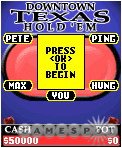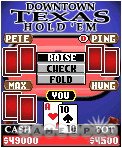The recent explosion of poker games for mobile seems to have become a positive feedback loop, with each new entry spurring the already intensely pressurized card-and-gambling game genre into a new frenzy of creative activity. Although it was released several months ago, Downtown Wireless' Texas Hold 'em game has continued to do a brisk business on Verizon's decks, despite its seemingly crippling lack of a multiplayer option. In essence, the Downtown Wireless team chose playability over comprehensiveness. Downtown Texas Hold 'em certainly isn't as full-featured as some of its competitors, but it succeeds in its limited scope by presenting a clean, functional interface--and by featuring CPU opponents with enough poker savvy to keep most casual Hold 'em players coming back to the table.

Downtown Texas Hold 'em offers two basic methods of play. In career mode, you start out playing a bottom-feeder No Limit Texas Hold 'em tourney in South Dakota. Win this, and you'll progress sequentially through games on riverboats and Caribbean islands to eventually reach the highest heights of Las Vegas, where you'll have your shot at the coveted World Championship. Each of the five tournaments in career mode pits you against four computer opponents, all of whom you must bust out to advance; there are no second-place trophies here. Downtown Texas Hold 'em also contains a quick game mode, which is functionally identical to the tournament matches but it exists outside the tournament framework. The inclusion of this mode would make more sense if you could customize it somehow. The mode does provide a venue for play outside of your tournament stats, but it still feels like something of an afterthought.
Naturally, the most important part of Downtown Texas Hold 'em is the actual card play, and the game is fairly sharp in this regard. The CPU opponents in any given tourney seem to play intelligently, providing a nice mix of tactics for you to deal with between the four of them. The CPU players will take a lot of risks, bluff occasionally, and even use more complex strategies like slow-playing and check-raising. Some of the personas will play heedlessly, making their actions difficult to predict, while others will stick to their guns and come up with the goods when their bets say they will. Much of the fun in career mode comes from carefully watching your opponents and distilling their poker methodologies. That said, the game will just skip to the final result once you fold a hand, meaning that you miss out on a lot of your opponents' betting behavior while not playing. Skipping the remainder of hands you're not playing makes sense for less-involved players, but it would have been nice to have the option to follow all of the activity in a hand. In addition, Downtown Texas Hold 'em preserves its clean look at the expense of some necessary information--there's no record of betting activity, and the game doesn't even tell you how much money it takes to call a particular bet.

Downtown Texas Hold 'em is an attractive game from a visual standpoint. The opening menu is something of a kick, featuring an animated hand sweeping your various gameplay options on and off the table. The game features six different tables to play on; five for each of the venues and one more for quick games, and each has a different color scheme. The table's presentation is spartan and uncluttered, featuring big, easily identifiable cards and no confusing piles of money. Downtown Texas Hold 'em is adequate sound-wise, containing a catchy opening tune and several snippets of music during play.
Overall, Downtown Texas Hold 'em's simple, no-nonsense approach to the game will allow the less serious poker players to start playing immediately, and its CPU opponents should keep seasoned players busy for a number of hours. However, the game's lack of customizability (you'll be playing against exactly four CPU opponents the entire time, whether you like it or not) and multiplayer are definitely limiting factors. Downtown Texas Hold 'em is a good poker game, but it doesn't really represent an improvement over Phil Hellmuth's Texas Hold 'em, which is imbued with multiplayer and more complex options. If you are looking for these features, Phil Hellmuth's the way to go. If, on the other hand, you don't care about multiplayer and are just looking to play some slick-looking hold 'em, Downtown Texas Hold 'em is the better option.